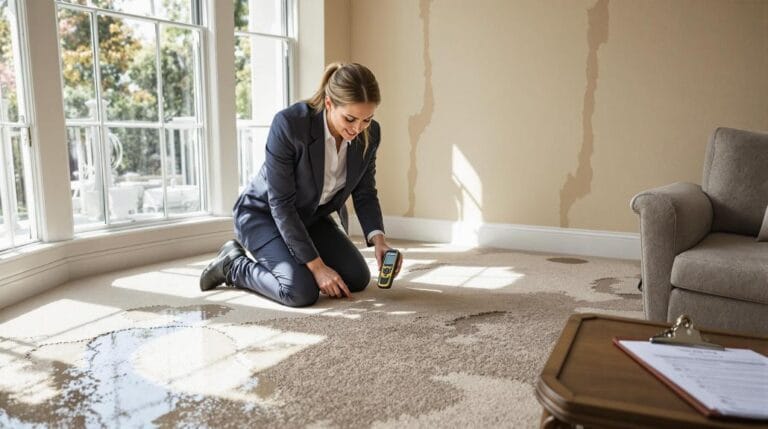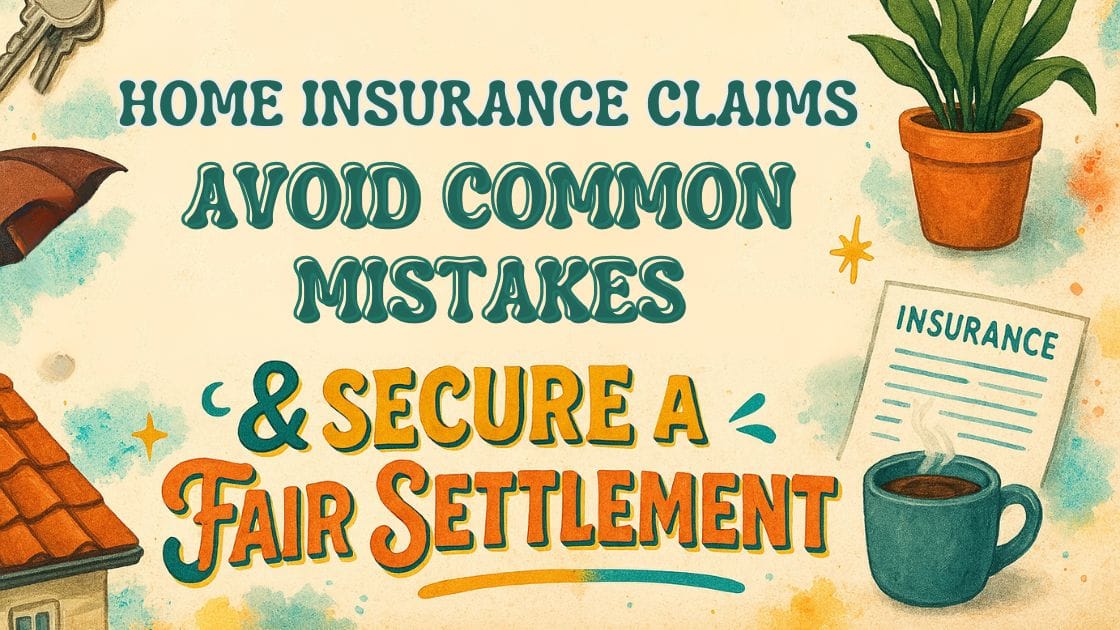Managing a home insurance claim can feel overwhelming, but understanding the process is crucial for UK homeowners. Whether you’re dealing with storm damage, a burst pipe, or any other covered incident, knowing exactly how the claims process works can make the difference between a smooth experience and unnecessary stress. In this guide, we’ll walk you through each step, ensuring you know precisely what to do, when to do it, and how to handle your claim effectively.
The home insurance claims process in the UK follows a clear sequence. After an incident, policyholders must contact their insurer within 48 hours and provide detailed documentation, including photographs and receipts.
A loss adjuster typically visits to assess the damage and validate the claim. Emergency repairs should be documented and approved by the insurer. The process requires careful attention to policy coverage, exclusions, and proper evidence gathering. Understanding each step can make the difference between approval and denial.
Key Takeaways
- Contact your insurer within 48 hours of the incident, providing your policy details and a clear description of what occurred.
- Document all damage thoroughly with photographs, videos, and written accounts before making any repairs or alterations.
- Loss adjusters will visit to assess the damage, so ensure you are present during inspections and keep detailed records of their findings.
- Emergency repairs should be carried out immediately to prevent further damage, but inform your insurers first and retain all receipts.
- Submit all required documentation, including photographs, receipts, and reports, while keeping copies of all communications with your insurers.
The Initial Steps After an Incident
When disaster strikes your home, knowing the right steps to take can significantly impact the success of your insurance claim. The claim initiation process begins with ensuring everyone’s safety and preventing further damage to your property.
Your first priority should be to take immediate safety precautions. Turn off utilities if necessary and contact emergency services in cases of theft or vandalism. Have you secured the property to prevent additional damage?
Next, contact your insurer promptly – ideally within 48 hours. Keep your policy details handy and prepare a thorough description of the incident. A thorough review of your policy start date will confirm your coverage eligibility.
While waiting for a professional assessment, you may need to make temporary repairs. Remember to document these thoroughly.
If your home becomes uninhabitable, discuss temporary accommodation options with your insurer. They will guide you through the next steps.
Documentation and Evidence Gathering
Every successful home insurance claim relies on proper documentation and evidence gathering. A systematic approach to evidence collection ensures that nothing is overlooked during the claims process. This includes taking photographs and videos of damage, keeping receipts for repairs, and maintaining records of all communications with contractors and emergency services.
Effective organisation of your claim makes the process smoother for everyone involved. Most insurers now accept digital submissions, so creating electronic copies of all documents is essential. Store everything in clear categories and keep a secure backup. A qualified Loss Assessor can help guide you through gathering all necessary documentation and evidence.
Don’t forget to include police reports for incidents such as theft or expert assessments when required.
Remember to document everything in chronological order. Even small details can make a significant difference in how quickly and successfully your claim is processed.
Find out what a home insurance claim is all about – Learn the basics of making a claim.
Working With Loss Adjusters
Most home insurance claims involve working with a loss adjuster at some point during the process. These professionals evaluate complex claims and carry out thorough investigations to determine the extent of damage and coverage under your policy.
Loss adjusters conduct detailed site visits and collect evidence to prepare comprehensive reports for the insurer.
While the role of loss adjusters primarily serves insurance companies, understanding how to work with them effectively can significantly impact your claim negotiation.
When dealing with loss adjusters, remember these key points:
- Document everything before their visit, including photographs and a detailed list of damages.
- Be present during their inspection to point out all areas of concern.
- Keep copies of all communications and request regular updates on the progress of your claim.
Remember that loss adjusters strive to settle claims fairly within the terms of your policy.
However, you may want to consider having your own representation for particularly complex or high-value claims.
See how to avoid delays in your claim submission – Discover steps to ensure timely reporting and documentation.
Policy Coverage Assessment
Understanding your home insurance coverage starts with a thorough review of both buildings and contents coverage types along with their specific limits.
A careful examination of policy terms will reveal important exclusions such as general wear and tear or mechanical breakdowns that could affect future claims.
The policy documentation outlines essential details about coverage limits, optional add-ons such as accidental damage cover, and special conditions that could impact claim eligibility.
Personal liability coverage is typically included in building or combined home insurance policies, providing protection against third-party claims.
Coverage Types and Limits
Insurance coverage forms the cornerstone of a robust home protection plan, determining what will and won’t be covered when disaster strikes. Understanding coverage types and their limits enables homeowners to make informed decisions about their protection needs.
Key aspects of coverage limits include:
- The total sum insured, which sets the maximum payout for all contents.
- Single article limits that may necessitate separate listing for prized items.
- Policy excess amounts that impact out-of-pocket expenses during claims.
Most UK insurers provide buildings insurance for structural protection and contents insurance for personal belongings. Combined policies bundle both types of coverage for comprehensive protection. Natural disasters like floods often require separate flood coverage since they’re excluded from standard policies.
When selecting coverage, consider location-specific risks and the true value of your home and possessions. Bear in mind that certain perils, such as rising damp, typically fall outside standard coverage parameters.
Review the most common home insurance claims – Learn which types of incidents lead to claims.
Policy Terms Verification
Every successful home insurance claim begins with a thorough review of policy terms and coverage details. Understanding what your policy covers – and equally important, what it does not – helps prevent costly claim delays and disappointments later.
Most UK insurers require specific documentation to process claims smoothly. This typically includes your policy number, clear evidence of damage through photographs or videos, and relevant receipts for repairs or replacements.
Keeping detailed records of all communications with your insurer is also essential. It’s crucial to notify your insurer within 24 hours of discovering any damage to your property.
Pay special attention to policy exclusions and coverage limits. These define the extent of your protection.
Many homeowners realise too late that certain types of damage or circumstances are not covered under their standard policy. Taking time to verify these details upfront can save considerable stress during the claims process.
Exclusions and Special Conditions
A maze of exclusions and special conditions lies at the heart of every home insurance policy. Understanding these limitations helps prevent unexpected claim denials. Common exclusion examples include wear and tear damage, pre-existing conditions, and business-related incidents.
Special conditions often require homeowners to maintain specific standards. Regular maintenance and upkeep are essential responsibilities of the homeowner to ensure valid coverage. Here are key points every policyholder should know:
- Properties left unoccupied for extended periods may lose coverage for theft and vandalism.
- High-value items like jewellery typically need separate coverage beyond standard policy limits.
- Damage caused by family members or intentional acts will not be covered.
Remember to review your policy regularly and inform your insurer about significant changes to your property. This proactive approach ensures you maintain appropriate coverage and understand exactly what protection your policy provides.
Understand the common reasons for claim rejections – Get insights on how to steer clear of errors.
Making Emergency Repairs
When faced with property damage, taking immediate action to prevent further issues becomes the top priority before an insurance assessor arrives.
Home insurance policies typically cover emergency repairs, but documenting all work through photographs and detailed notes remains essential for the claims process. Homeowners should be aware that temporary fixes only are covered under emergency provisions.
Understanding cost recovery guidelines helps homeowners make informed decisions about temporary fixes while staying within policy limits and following proper procedures for reimbursement.
Preventing Further Property Damage
Taking swift action to prevent further property damage is one of the most essential steps in the insurance claim process.
Emergency preparedness plays a crucial role in minimising losses, while proper damage assessment helps identify critical areas needing immediate attention.
When facing property damage, homeowners should prioritise these key actions:
- Turn off the main water supply immediately if dealing with leaks or flooding.
- Cover damaged roofs with tarpaulins to prevent water ingress during adverse weather.
- Isolate electrical circuits if there is any risk of water contact with electrical systems.
Insurance companies often dispatch authorised contractors to implement temporary fixes and secure the property. The service typically provides repairs of up to £500 to address immediate emergencies.
These preventive measures not only protect the home from additional damage but also demonstrate responsible property management to insurers reviewing the claim.
Documenting Emergency Work Done
Proper documentation of emergency repairs serves as your financial safety net during the insurance claims process. Following documentation best practices ensures that your claim has the strongest possible chance of success.
Take clear photographs and videos of all damage before any repairs commence, and maintain detailed records of all emergency work completed. Acting with prompt urgency helps prevent additional damage and strengthens your claim with the insurance company.
Visual evidence plays an essential role in supporting your claim. Capture images from multiple angles and ensure good lighting to show the full extent of the damage.
Keep all receipts, invoices, and written descriptions of repairs in an organised file. Remember to document any communication with contractors or emergency services.
Create digital copies of all documentation as a backup. This careful approach helps to avoid potential disputes and guarantees a smoother claims process with your insurer.
Cost Recovery Guidelines
Understanding the cost recovery guidelines for emergency repairs can make the difference between financial relief and unexpected expenses.
The claims process typically includes specific steps for recovering costs associated with emergency services and temporary repairs.
Here are three key guidelines to keep in mind when seeking cost recovery:
- Notify your insurer immediately before authorising emergency work.
- Document all temporary repairs with photographs and receipts.
- Keep communication lines open with your insurance provider throughout.
Insurance providers generally cover emergency repair costs when properly documented and approved.
This helps protect both the property and the policyholder’s financial interests.
Keep in mind that following these guidelines guarantees a smoother claims experience and increases the likelihood of full cost recovery for necessary emergency work.
Settlement Options and Negotiations
Understanding settlement options during a home insurance claim requires careful consideration of various payment methods and negotiation strategies. Homeowners can choose between cash settlements, direct repairs, or a combination of both approaches. Each option presents unique advantages depending on individual circumstances and preferences.
Effective settlement strategies often involve thorough documentation and regular communication with insurers. Understanding policy terms and gathering detailed repair estimates strengthens one’s negotiating position. Many homeowners find that working with a Loss Assessor helps simplify the process and maximise claim value.
When negotiating settlements, it’s essential to consider factors like VAT implications and contractor selection. While straightforward claims might resolve quickly, complex cases involving fire damage or subsidence typically require more extensive negotiation tactics and patience.
The key is maintaining clear documentation while advocating firmly for fair compensation.
Get practical tips for a faster claims process – Find advice on expediting your claim.
Managing Temporary Accommodation
When disaster strikes and a home becomes uninhabitable, securing temporary accommodation becomes a critical priority for UK homeowners. Insurance providers typically offer various temporary accommodation options, from hotels to serviced apartments, based on individual circumstances and local availability.
The process of securing alternative housing involves three key steps:
- Assessment of property damage by insurance assessors
- Evaluation of policyholder needs and family requirements
- Selection of suitable accommodation within policy limits
Insurance companies provide financial support through direct payments to accommodation providers or monthly stipends to policyholders. This support covers essential living expenses while property repairs are underway.
Most policies include coverage for alternative housing, although limits and terms can vary significantly between providers. Regular communication with insurers helps to ensure a smooth transition and appropriate support throughout the temporary relocation period.
Impact on Future Premiums
Making a home insurance claim can significantly impact future premiums, as insurers view claims as indicators of potential risk. When homeowners file a claim, insurers reassess their risk factors and often implement premium adjustments accordingly. These increases reflect the statistical likelihood of future claims based on past events.
Several elements influence the extent of premium increases. The frequency and severity of claims play a crucial role, with multiple or large claims leading to steeper adjustments. Even non-fault claims can affect rates, though typically to a lesser degree.
To manage potential increases, homeowners can explore various strategies. Shopping around for better rates, implementing security measures, and maintaining a claims-free record where possible can help minimise premium hikes.
Additionally, discussing options directly with insurers can sometimes lead to more favourable terms.
Conclusion
Successfully managing a home insurance claim comes down to being organised, prompt, and thorough. Remember the key steps: contact your insurer within 48 hours, document everything meticulously, coordinate with loss adjusters, and maintain detailed records of all communications and expenses. While the process might seem daunting at first, following these steps methodically will help ensure your claim progresses smoothly.
Most importantly, don’t hesitate to seek clarification from your insurer if you’re unsure about any part of the process – it’s better to ask questions early than face complications later.
Want to Avoid Home Insurance Claim Complications?
Understanding the claims process is important, but managing it effectively is crucial. As Northern Ireland’s trusted claims specialists, PCLA handles all documentation, assessments, and communication with insurers whilst you focus on your daily routine.
Learn how our Claims Management Service can help or ring us today on 028 9581 5318.



